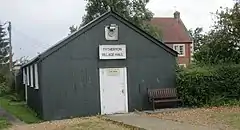East Tytherton
East Tytherton is a hamlet in the civil parish of Bremhill in the ceremonial county of Wiltshire, England. Its nearest town is Chippenham, which lies approximately 2.7 miles (4.3 km) south-west from the hamlet.
Geography
East Tytherton is located on a minor road in a valley some 2.7 miles (4.3 km) northeast of Chippenham and a similar distance northwest of Calne in the civil parish of Bremhill.[1] It has a rectangular village green around which the grey stone manor and the other residences are clustered. One timber-framed house has painted brick walls and a corrugated iron roof.[2]
History
A house at East Tytherton was bought by preacher John Cennick in 1742 and a Moravian community was founded in 1745; a chapel, manse and church cottage were built for the community. Pevsner[3] describes the Moravian settlement and "..the School House, dated 1785.." built behind the existing chapel buildings as The Single Sisters' Choir House. Early residents included Leonora Carr and 4 other ex-slaves from Antigua who lived at the Single Sisters' House in the early 19th century. Leonora is buried in the graveyard behind the house.[4] The Sisters' Choir House was subsequently converted into a boarding school, primarily for the children of Moravian missionaries. One pupil was Thermutis Coleman whose son (Rev. Robert Francis Kilvert) wrote the descriptions of local life which were later published and broadcast on BBC Radio as "Kilvert's Diaries". [5] The Sisters' Choir House has been a private residence (Kellaways House) since WW2.[6]
The manse and chapel were rebuilt between 1792 and 1793, and a schoolroom was added in 1793–4.[7] The chapel, manse and former schoolroom are red brick buildings with ashlar dressings and stone slate roofs, and are Grade II* listed.[8] The chapel is a single-storey structure with a pair of two-storey houses attached at either end. The manse has a timber bell-cot at the east end.[2] As of 2016, the church is still in use.[9]
The Moravian school was built to house fifty pupils but at one time there were seventy.[2] The school closed in 1931.[10] Nearby, a British school opened in 1871 and became a County school in the 20th century,[11] later named Maud Heath School. Pupil numbers declined from the 1950s and the school closed at the end of 2005.[12] In 2016 the building was an activity centre for Girl Guides.[13]
References
- Concise Road Atlas of Britain. AA Publishing. 2016. p. 18. ISBN 978-0-7495-7743-8.
- "Bremhill". Wiltshire Community History. Wiltshire Council. Retrieved 4 September 2016.
- Pevsner, Nikolaus; Cherry, Bridget (2002). The Buildings of England: Wiltshire. Yale University Press. p. 234. ISBN 0 300 09659 3.
- Pocock, MPhil, Nigel (October 2013). "From Enslavement to Freedom: Five Young Girls from Antigua". Hidden Presences. Retrieved 7 January 2021.
- Kilvert, Francis (1870–79). "Kilvert's Diaries: 1870-79". The Kilvert Society. Retrieved 8 January 2021.CS1 maint: date format (link)
- "Moravian Church: British Province". Congregations of the Moravian Church. Retrieved 7 January 2021.
- "Moravian Church, East Tytherton". Wiltshire Community History. Wiltshire Council. Retrieved 22 February 2016.
- Historic England. "Moravian Church, Manse and Church Cottage, East Tytherton (1363796)". National Heritage List for England. Retrieved 22 February 2016.
- "Tytherton Moravian Church". Moravain Church of the British Province. Archived from the original on 2 March 2016. Retrieved 22 February 2016.
- "Moravian School, East Tytherton". Wiltshire Community History. Wiltshire Council. Retrieved 22 February 2016.
- "County School, East Tytherton". Wiltshire Community History. Wiltshire Council. Retrieved 22 February 2016.
- "East Tytherton Maud Heath Primary School". Department for Education. Retrieved 22 February 2016.
- "Maud Heath Centre". Girlguiding Wiltshire North. Retrieved 22 February 2016.
| Wikimedia Commons has media related to East Tytherton. |

